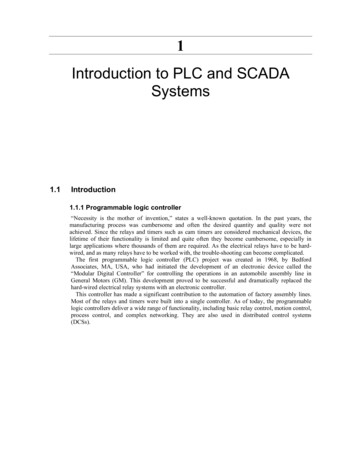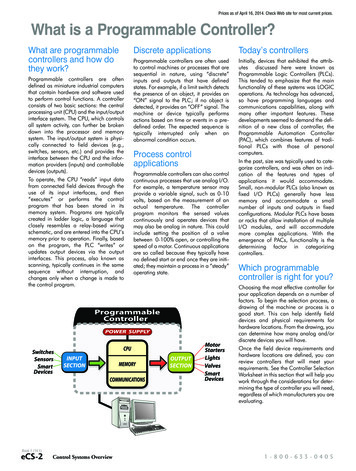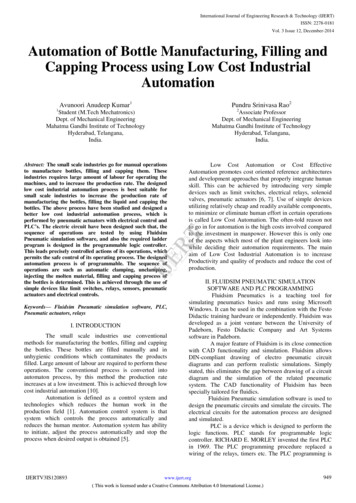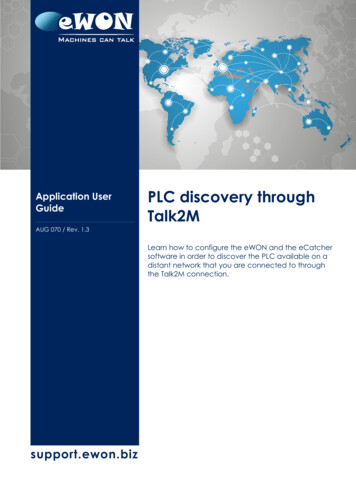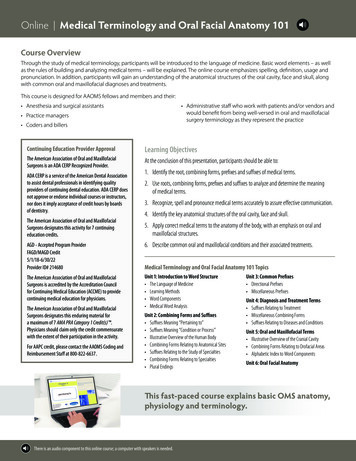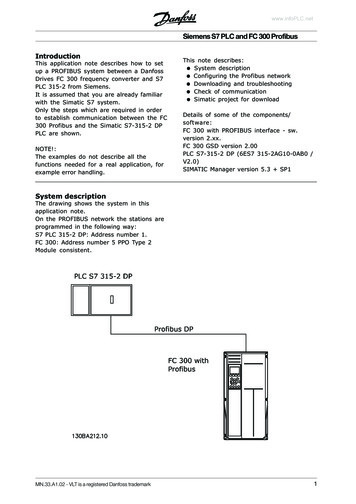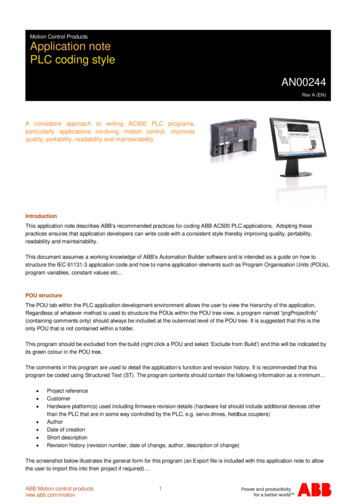
Transcription
Motion Control ProductsApplication notePLC coding styleAN00244Rev A (EN)A consistent approach to writing AC500 PLC programs,particularly applications involving motion control, improvesquality, portability, readability and maintainabilityIntroductionThis application note describes ABB’s recommended practices for coding ABB AC500 PLC applications. Adopting thesepractices ensures that application developers can write code with a consistent style thereby improving quality, portability,readability and maintainability.This document assumes a working knowledge of ABB’s Automation Builder software and is intended as a guide on how tostructure the IEC 61131-3 application code and how to name application elements such as Program Organisation Units (POUs),program variables, constant values etc.POU structureThe POU tab within the PLC application development environment allows the user to view the hierarchy of the application.Regardless of whatever method is used to structure the POUs within the POU tree view, a program named “prgProjectInfo”(containing comments only) should always be included at the outermost level of the POU tree. It is suggested that this is theonly POU that is not contained within a folder.This program should be excluded from the build (right click a POU and select ‘Exclude from Build’) and this will be indicated byits green colour in the POU tree.The comments in this program are used to detail the application’s function and revision history. It is recommended that thisprogram be coded using Structured Text (ST). The program contents should contain the following information as a minimum ·······Project referenceCustomerHardware platform(s) used including firmware revision details (hardware list should include additional devices otherthan the PLC that are in some way controlled by the PLC, e.g. servo drives, fieldbus couplers)AuthorDate of creationShort descriptionRevision history (revision number, date of change, author, description of change)The screenshot below illustrates the general form for this program (an Export file is included with this application note to allowthe user to import this into their project if required) ABB Motion control productsnew.abb.com/motion1
Application notePLC Coding styleAN00244-001For the remaining POUs the general recommendation is to use folders (and sub-folders) in a way that simplifies the apparentstructure of the code and allows someone who has not seen the application before to understand the logical structure of thecode and easily locate relevant POUs when editing/debugging the application. How this is actually achieved may depend on anumber of factors including size/complexity of the application so this document does not aim to define a specific style. Insteadtwo suggested schemes are illustrated below for reference.Physical viewThis scheme assumes that the user would prefer to structure the POU view in a way that relates to the physical structure of themachine/system the code is targeted at. Top level folders should be used to contain POUs relating to specific areas/parts of themachine/system and if necessary sub-folders within these top level folders can be used to break the application down intofurther logical sections.Note that there are some cases where POUs cannot be wholly“assigned” to a specific area of the machine via a folder structure.As an example, CALLBACK START is a program that is called bythe system start event and may contain logic relating to manyseparate elements of the machine. This program could be written tocall additional programs that are then located within the relevantfolders in the tree, but it is also acceptable to retain all of the logicwithin a single program to minimise the number of POUs andtherefore the apparent complexity of the application. In this case afolder independent of the machine structure may be used (asillustrated by the Initialisation folder in the example to the left).Also note that CALLBACK START is a program but is not pre-fixedby the text ‘prg’. This particular program (and others that can becalled by System Events) must use this specific name so cannotmeet the recommendations of this document for program name prefixing.Logical viewABB Motion control productsnew.abb.com/motion2
Application notePLC Coding styleAN00244-001This scheme assumes that the user would prefer to structure the POU view in a way that relates to the logical processing of theapplication. Top level folders should be used to contain POUs relating to specific logical functions and these should be namedto assist in identifying how/when the POUs within the folder are processed (e.g. if a task has been configured to run a number ofprograms on a cyclic basis a top level folder named ‘Cyclic’ may be created). If necessary sub-folders within these top levelfolders can be used to break the application down into further logical sections.As can be seen from the two examples above, in practise a mix of the two schemes may be inevitable. Folders are sorted inalpha-numeric order so you may also make use of this fact should you wish to order your folders in a specific manner (e.g.starting Folder names 01 . 02 . etc can allow a specific order to be defined in the POU tree). Folder names may alsocontain a space (unlike actual POU elements) so include spaces when defining folder names if required.It may also be useful to include a folder (e.g. named ‘Old Code’,‘Unused’ or other name with similar meaning) in which unused,outdated or trial elements of code that are now excluded from thebuild are stored for future reference. During applicationdevelopment it may be preferable to keep old versions of particularPOUs to revert back to until you are sure the new application codeis working correctly.ABB Motion control productsnew.abb.com/motion3
Application notePLC Coding styleAN00244-001General naming rules for POU elementsThe following general rules/conventions apply to all POU elements:······POU’s (PRGs, Function Blocks, Functions) are automatically sorted in alpha numeric orderPOU name lengths are limited to a maximum of 255 characters (it is recommended to try to restrict lengths to 25characters or less if possible)POU names cannot start with a numberNo spaces are allowed within POU namesUnderscores ‘ ’ are allowed but it is recommended not to use these but instead use lower case prefixes followed byUpperCamelCase, also known as “PascalForm” (i.e. capitalised first letter of each word within the name)The order in the POU tree view has no bearing on the order the POU’s are called, it is just a listProgramsWhen the user declares a POU of type ‘Program’ it is recommended that the prg prefix is included in the name. This allows theuser to easily identify programmatic access to a member variable of a program and distinguish this from a member variable of adata structure for example. The remainder of the name should use gramprgMachineControlAvoid meaningless names such as prg01 and instead select a name that relates to the program’s purpose (e.g.prgMachineControl may identify that this POU was the main program containing the bulk of the machine logic.It is advised that as few programs as possible are called directly from tasks. Instead it is best that a program called from a taskis then used to call all other programs that need to be processed at the priority defined by the calling task/program.Example:Instead of . use .ActionsAction names should not be prefixed. Use UpperCamelCase for the action name. Avoid meaningless names (e.g. nStateMachineVariables and ConstantsABB Motion control productsnew.abb.com/motion4
Application notePLC Coding styleAN00244-001All program elements, including variables and constants should have meaningful names. Whenever possible, do not use hardcoded physical addresses as variables, always define a variable via the IO mappings screen(s) in Automation Builder. Do notre-use a global variable name within a local routine (so called “shadowing”). All variables should have suitable prefixes toindicate their type/usage as described in the table below. Constants follow a similar scheme but the prefix is preceded by anunderscore to indicate a constant/literal value.The main body of the name should describe the use of the variable/constant and should be mixed case, capitalizing the firstletter of each word with no spaces or underscores. This format is known as UpperCamelCase or PascalForm. Examples areshown in the following table PrefixType/DescriptionExamplexBOOL – Boolean, 1 bit data (true/false)xMyBool: BOOL;byBYTE – Byte, 8 bit databyMyByte: BYTE;wWORD – word, 16 bit datawMyWord: WORD;dwDWORD – double word, 32 bit datadwMyDoubleWord: DWORD;lwLWORD – long word, 64 bit datalwMyLongDoubleWord: LWORD;siSINT – small integer, 8 bit datasiMySmallInteger: SINT;usiUSINT – unsigned small integer, 8 bit datausiMyUnsignedSmallInteger: USINT;iINT – integer, 16 bit dataiMyInteger: INT;uiUINT – unsigned integer, 16 bit datauiMyUnsignedInteger: UINT;diDINT – double integer, 32 bit datadiMyDoubleInteger: DINT;udiUDINT – unsigned double integer, 32 bitudiMyUnsignedDoubleInteger: UDINT;dataliLINT – long integer, 64 bit dataliMyLongInteger: LINT;uliULINT – unsigned long integer, 64 bit datauliMyUnsignedLongInteger: ULINT;rREAL – real, 32 bit datarMyReal: REAL;lrLREAL – long real, 64 bit datalrMyLongReal: LREAL;strSTRING – string, string type datastrMyString: STRING;tTIME – timetCurrentTime: TIME;todTIME OF DAY – time of daytodTimeOfDay: TIME OF DAY;dttDATETIME – date timedttCurrentDateAndTime: DATETIME;dtDATE – datedtCurrentData: DATE;parPOINTERARRAYpMyPointer: POINTER TO DINT;arMyArray: ARRAY[1.5] OF INT;EEnumeration Type definitionTYPE ECutterStateeEnumeration instance and valueseState : ECutterState;TYPE ECutterState( eInitState : 0,eHome : 10,eHomed : 20 );END TYPETSTYPE STRUCT definitionTYPE TSMyTypeStructuretsType Struct instancetsLabelHead1 : TSLabelHead;STSTRUCT definitionSTRUCT STMyStructurestSTRUCT instancestStructure: STMyStructure;Constant ValueiMaxSpeed: INT: 3000;axAxis ReferenceaxCutter: AXIS REF;This naming convention for variables also applies to PDO mapped variables. For example, an EtherCAT axis ‘ControlWord’PDO mapping is a U16 data type (word) so a suitable name for this could be wAxisControlWord.ABB Motion control productsnew.abb.com/motion5
Application notePLC Coding styleAN00244-001FunctionsFunctions come in two main forms. They can be standard functions which are included within the IEC61131 programmingenvironment libraries or they can be user defined. When a user defined function POU is created it should be given a name thatdescribes the basic functionality of the function. The name should be prefixed with ‘do’ and the remainder of the name should beof UpperCamelCase ValueToRangeOnce a Function has been created or is used from a library it does not have instances and as such no rules are needed forhandling its repeated use throughout the code.Function blocksFunction blocks come in two main forms. They can be standard function blocks which are included within the IEC61131programming environment libraries or they can be user defined function blocks.Function block declarationsWhen a function block has been used from a standard library then it already has its name and functionality defined (and this willnot include a prefix). When a user defined function block POU is created it should be given a name (of UpperCamelCase form)that describes the basic functionality of the function block and this should be prefixed with the capital letters FB.PrefixType/DescriptionExampleFBFUNCTION BLOCKFBPhaseAxisInstances of function blocksOnce a function block has been created, or is used from a library, then it will be necessary to define a name for any instance ofthe function block that is to be used. When defining an instance name start this name with a short form of the function block typein lower case (2 or 3 characters ideally) followed by a description of its use in UpperCamelCase as shown in the examplesbelow edAxisparCMC AXIS CONTROL PARAMETER REALparMainDrivekerCMC MOTION KERNEL REALkerMainDriveciaECAT CiA402 CONTROL APPciaMainDrivemrMC MoveRelativemrFirstIndextonT ON: TimertonStartDelayctuCTU: CounterctuProductionCountAvoid names such as ctu1 for example. Instead use a name relative to the block’s purpose (e.g.ctuServiceDue if it werecounting machine cycles to indicate when a machine service was required). Try to keep to two or three letters for the prefix, butthis may not always be possible (e.g. it might be difficult to avoid a clash with another function block prefix or difficult to make itobvious what the function block type is), in which case try not to exceed five characters.As an example, both of the following instance names would be acceptable phaInfeedAxis : FBPhaseAxis;phaseInfeedAxis : FBPhaseAxis; but the five letter version is maybe a little clearer to the reader.Comments / DocumentationThere are three main methods of entering comments depending on the specific IEC61131-3 programming language usedand/or the area of the IEC 61131 program editor the comments are entered into.ABB Motion control productsnew.abb.com/motion6
Application notePLC Coding styleAN00244-001In Structured Text (ST), Instruction List (IL) and the variable list areas, comments are encapsulated with (* Comment here *).Example:However when Ladder (LD) or Function Block Diagram (FBD) are used comments can be added to each individual network byright-clicking and selecting ‘Comment’ from the menu presented.Example:Continuous Function Chart (CFC) uses a comment box feature which can be dropped on to the page.Example:Whichever comment method is used program comments should describe what is happening and how it is being done. Avoidcomments where functionality is clear from the code.For example, avoid and instead use a comment of the form Or ABB Motion control productsnew.abb.com/motion7
Application notePLC Coding styleAN00244-001Comments can also be added to individual variables via the declaration window that pops up when the variable is first created This means that as a user hovers over the variable they will not just see the properties of the variable, but also its comments;Contact usFor more information please contact yourlocal ABB representative or one of the following: Copyright 2016 ABB. All rights reserved.Specifications subject to change without .com/drivespartnersnew.abb.com/PLCABB Motion control productsnew.abb.com/motion8
The POU tab within the PLC application development environment allows the user to view the hierarchy of the application. . They can be standard functions which are included within the IEC61131 programming environment libraries or they can be user defined. When a user defined function POU is created it should be given a name that


